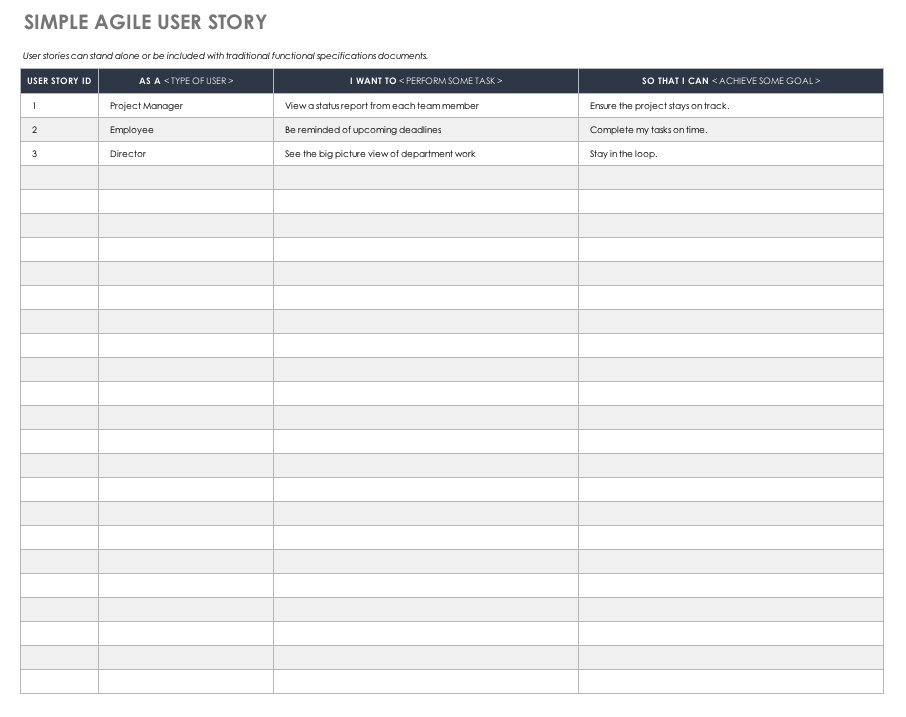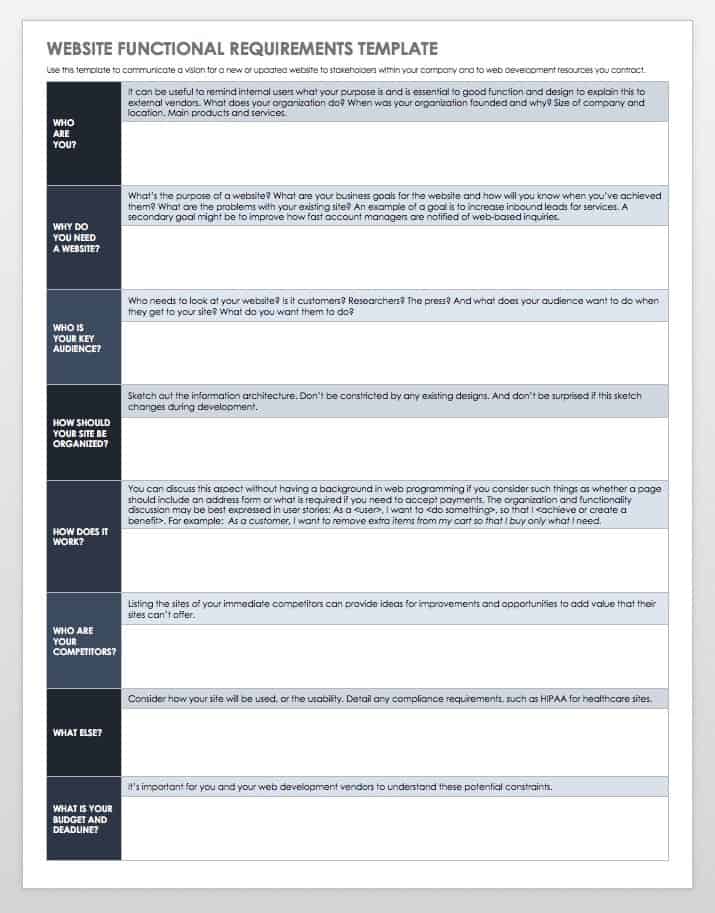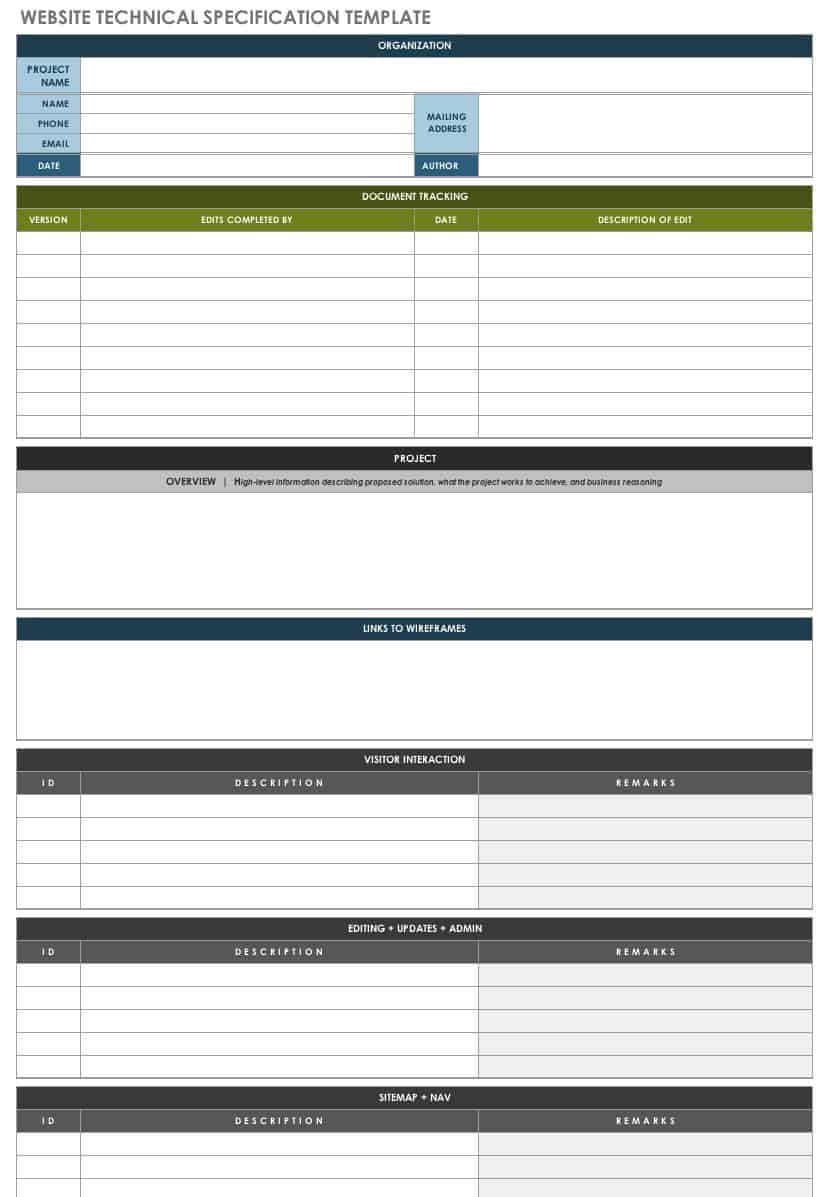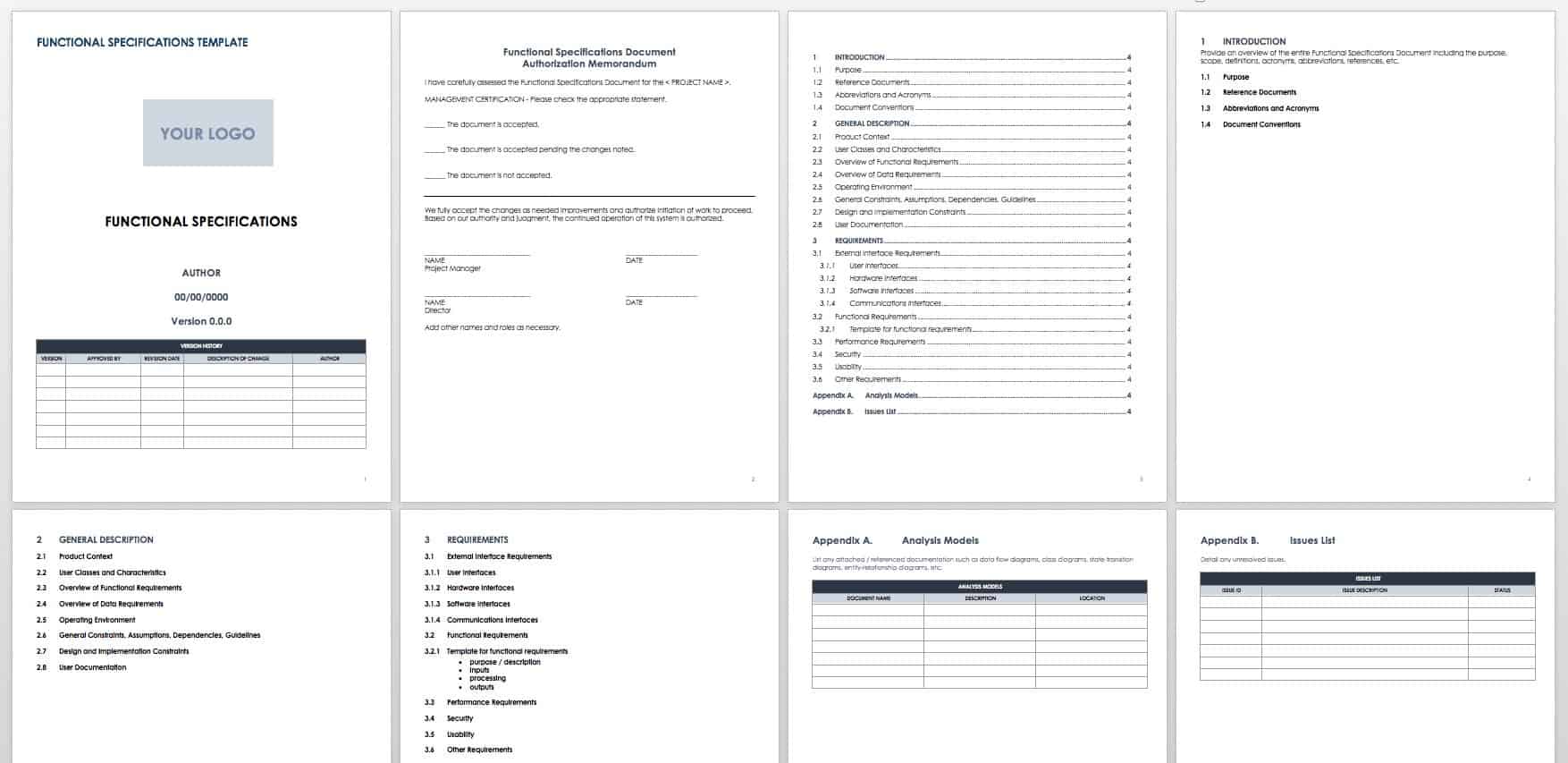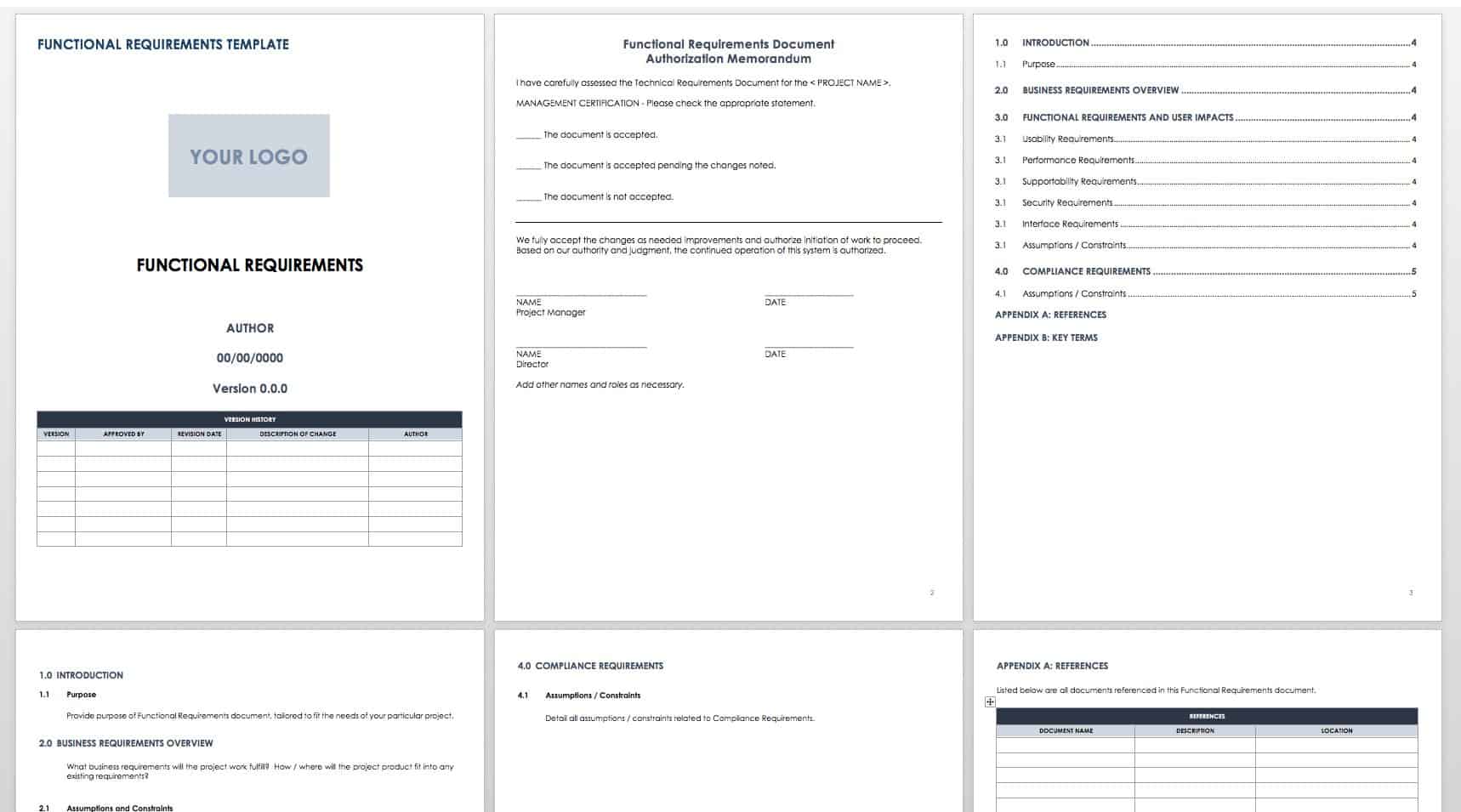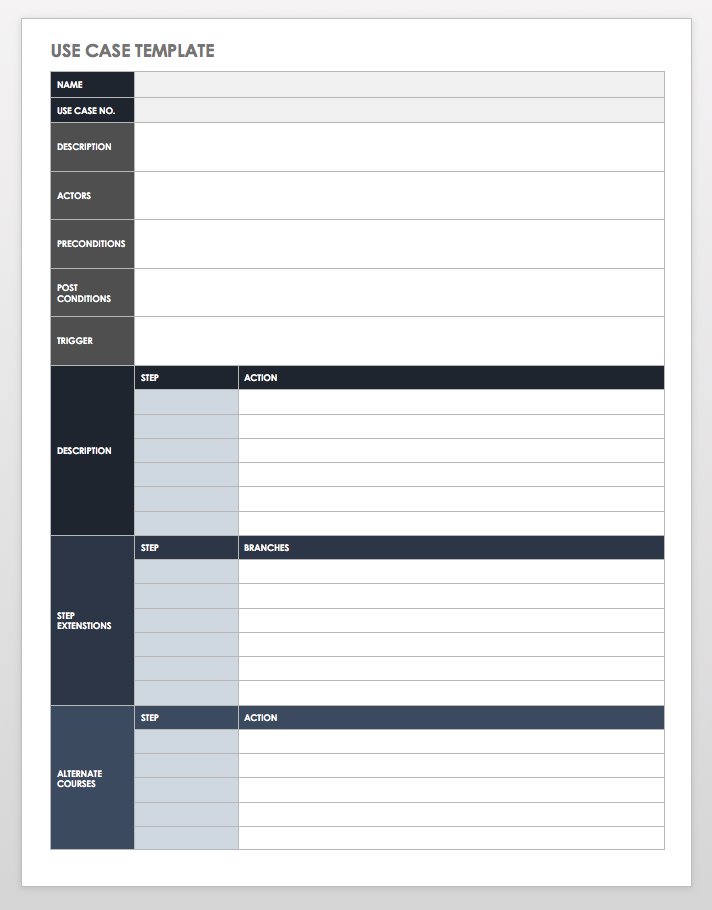Functional Specifications Templates for Agile Development
Agile focuses on finding the most efficient way to deliver a useful product to a user. In Agile development, traditional functional requirements documents and processes are sometimes considered to be financially prohibitive. Nevertheless, capturing more detailed plans and sketches can enhance clarity.
One of the most common Agile requirements tools is the user story. User stories put features in the context of what the user needs to accomplish. You can group together similar user stories to form Agile epics. As with traditional functional requirements specs, user stories describe the task or feature, but not how the developers should implement it.
User stories employ the following syntax: “As a user, I want to have something so that some benefit derives from it.” Here are some examples:
- As a driver, I want to know when my battery needs replacing.
- As a cook, I want a tablet screen to stay awake while I complete a recipe.
- As a cat, I want my portion of food released to my bowl at 4pm every evening.
To test whether a user story is well formed, apply the acronym INVEST.
- Independent: Can the story stand by itself?
- Negotiable: Can you change or remove this story without impacting the rest of the project?
- Valuable: Does this story have value to the end user?
- Estimable: Can you estimate the size of the story?
- Small: Is the user story small enough?
- Testable: Can you test this story?
For project management purposes, in the tracking tool, you can give user stories a name and numbered ID. In addition, you can mark the development priority, sprint, and story status. Stories go into the Agile product backlog.
User story templates are usually quite simple: They focus on identifying the role of the user, their task, and what the task should accomplish. In addition, the following template includes space to identify the story and development cycle information.
Download Simple Agile User Story Template
Excel | Word | PDF | Smartsheet
Functional Specifications Template for a Website
Planning a website calls for a high-level understanding of the necessary technology and a detailed comprehension of who will use the site and what you (as the site owner) wish users to accomplish. The user stories employed in Agile development can help you focus on user needs. Other questions also help contextualize the website.
The following website specification template asks a series of questions to help you define the purpose of the website, who the website is for, the activities they will perform on the website, and any special considerations, such as security standards like PCI for financial transactions.
Download Website Functional Requirements Template
Download Website Technical Specification Template
Functional Specifications Templates for Software
When developing software and other technology with the Waterfall method, you can often use a traditional functional requirements or specifications template. Functional requirements list features and functions of what the product “shall” do. For example, “The vacuum shall pick up particles smaller than five mm.”
Download Functional Specifications Template - Word
You may also prefer a template with more focus on business requirements. This minimalist template provides space for you to detail the purpose of your product or upgrade in context of your business goals, in addition to higher level design considerations.
Download Functional Requirements Template - Word
Functional Specifications Templates as Use Cases
You can create use cases for many types of products, including websites and software. Use cases focus on tasks that a user must perform with the product. By concentrating on tasks, the use case documents help steer developers toward creating user-focused products. These documents also keep stakeholders from misinterpreting product design. Use this use case template to define a task in terms of actors, steps, and branches.
Download Use Case Template
What Is a Functional Specification Template or Functional Requirements Document Template?
A functional specification document (FSD), also known as a functional requirements document (FRD), is considered by many project management and software development pundits to be the essential tool to limit confusion and misdirection on a project.
Although FSDs are frequently associated with software and web development, they have a role to play in any project, whether that be the launch of a new product, an upgrade, the development of a software product or tangible item, or the establishment of process or organizational changes. Functional specification documents present both business and engineering expectations. All stakeholders review and approve the document. The result is a reference document for the proposed product that addresses all parts of the organization, from coders to designers to sales staff.
You can use a functional specification document template to ensure that you include all the essential development information in a document. In addition, templates guarantee that with each new initiative, teams focus on the requirements for the product rather than waste time determining the design of the specifications document. Templates should be customized to meet the unique needs of each team or company.
Traditionally, FRDs tend to be long, dry, and often technical. But such documents may not be necessary or even useful. Because the purpose of the functional requirements document is to scope out the project for all stakeholders, FRDs avoid lengthy technical discussions. While you can include many types of requirements and supporting information (see the list below), the best practice is to only describe the FRD’s basic intentions. At its core, the document must describe the context and the features and functions to be developed. A technical design document is created based on the accepted functional requirements spec. The FRD should not duplicate any of the other requirements or process documents.
Functional specifications documents follow an approval process: Business users verify that the solution addresses their concerns, and technical reviewers verify that the described solution can be implemented. Often, key reviewers include testers, end users, technical writers, and product or system owners. You declare the document complete when everyone agrees on the contents. Some organizations then proceed to building the systems architecture document.
A functional requirements specification serves as a reference document for the entire team. It shows what product developers should develop, what testers should test, what writers should document, and what sales people will sell. A written functional specification shows that the design and intent have been thoroughly considered before development begins. It also illustrates that after specification approval, all stakeholders are on the same page. One should not write the specs to backfill the document after the product has been coded.
Some business analysts and developers distinguish functional specifications from functional requirements by saying that requirements describe what the software must do and that specifications describe how the software must do it. In practice, you usually combine these two roles.
Functional specifications (or requirements) document templates may also take a handful of forms. The format you choose depends on what works best for your organization.
- Functional Requirements: This is traditionally for software and other technology that uses the Waterfall development method. Functional requirements list features and functions as what the product “shall” do. For example, “The vacuum shall pick up particles smaller than five mm.”
- Use Cases: Use cases often stand on their own. However, organizations that value the user experience usually incorporate use cases into functional requirements. Use cases set functions and features in the context of user actions. For example, “The user double taps the phone screen. The screen is illuminated. The user swipes the screen to the right to unlock the phone and its functionality.”
- User Stories: User stories form the core of Agile development because they describe product design as what the user needs to do. This succinct approach helps teams deliver value to users in the most efficient way. User stories take the form, “As a user, I can do something so that I create some benefit.”
Who Uses Functional Specification Templates?
Typically, business analysts and technical leads create templates and functional specifications that they share with business and technical stakeholders who provide reviews to ensure that the expected deliverable is on target.
You may use functional specifications when developing new software and upgrades. You can also use them for organizational and systems engineering changes, web development, and more. Users of specifications include the following groups:
- Developers, who code the product
- Designers, who create the user interface (UI) for the software, device, or website
- Testers, who ensure that the code works correctly and according to specification
- Marketers, who prepare demand-generating documents around the new functionality
- Sales teams, who sell the feature and product
- Technical or user assistance writers, who document how the product works for administrators, end users, and other roles
What Is the Difference between a Functional Specification Document and a Business Requirements Document?
Although many combinations and permutations of documents exist, functional specification documents (FSDs) and business requirements documents (BRDs) are sometimes separate.
BRDs describe the higher-level business requirements for a product (what a product does). BRDs avoid technical detail in favor of detailed rationale for the product. A clear understanding of what the product offers and why it is necessary can often help guide development through disputes on product direction. FSDs can focus on outlining the features and functionality of the product that you require to achieve your end goal.
How Functional Requirements Templates Relate to Other Specification Documents
Creating a product, whether tangible or transactional, can involve generating many documents. Functional specifications templates can be used in conjunction with any of the following:
- User Requirements: This document represents what the user expects the product to do. Some consider the user requirement to be a portion of the functional requirements document. If this document exists, it should be included in your overall development process. In Agile development, user requirements (expressed as user stories) are considered the heart of functional requirements.
- Product Requirements: Used interchangeably with a market requirements document, this document details the purpose of a product.
- Business Process Documents: This document details a business process.
- Business Needs Assessments: This document describes the gaps between current conditions and desired business conditions.
- Technical Design Specifications: This document describes (in the finest detail) the programming elements required for the proposed design.
- Validation Documents: Validation documents can include a traceability matrix (which tracks features throughout the development process), test plans, and operation requirements.
- Systems Requirements: This document sketches a high-level expectation for a system or product.
- Business Requirements: This document describes the high-level reasons for creating a product or update.
- Use Cases: This document offers functional details and context for features from a user perspective.
- User Stories: This document is used for mainly for Agile development. It communicates the intent of the product by detailing what the user will do with it.
What Is the Difference between Functional and Nonfunctional Requirements?
Requirements may be categorized as functional and nonfunctional specifications (the what and the how).
- Functional Requirement: This describes a behavior, activity, or expected result from a product or system. For example, “Filter particles from water” or “Print a page.” Common functional requirements include administration functions, authorization and authentication, audit tracking and reporting, and business rules.
- Nonfunctional Requirement: This describes how something works, which also may be considered a constraint, attribute, or parameter. If the English word describing the process ends in ity, it’s nonfunctional. Examples include usability, maintainability, and security, in addition to performance and regulatory requirements.
What Is a Functional Specification Document in SAP?
In SAP, a functional specifications document is a description of the product from the stakeholder’s point of view, with precise expectations for how the feature relates to SAP. You create functional specifications after you combine the FSD and software requirements document into one.
What Is a Functional Requirements Example?
At the minimum, FRDs should include these elements:
- Who the product is intended for
- Who is authorized to use the product
- Inputs into the system
- What each screen should do
- System workflows
- Outputs
- Regulatory requirements addressed by the product
- Specific business requirements of your company
How to Choose or Create a Functional Specifications Template
A written description of desired functions is an essential part of product development, but the form that the functional requirements template takes should also be governed by what works for your team.
When developing a template, or even when considering improvements to an existing development process, ask everyone with a vested interest in the outcome of the product what they want in a template. Each format offers advantages and disadvantages:
- “Shall” statements in traditional functional requirements tend to lack context and are more subject to developer interpretation.
- Use cases offer context and detail, but the devil can be in those very details — scope can creep as real user requirements become clear. Smaller requirements may become lost among use cases.
- User stories offer the advantage of describing user needs in the context of business requirements. However, they may require extra effort (i.e., researching adequate implementation). Developers and others can also become so focused on individual stories that they exclude the bigger context of the product.
Tools for Developing and Managing Functional Requirements Document Templates
Again, when considering what tool to use for creating software requirements documents, your organization’s needs are paramount. What works for other companies may not work for you.
- Documentation Management: This offers one of the easiest and most ubiquitous tools to create templates and render documents. Many functional requirements documents are available as document templates.
- Spreadsheet Software: Spreadsheets allow you to add columns as needed. They also remove the pressure to craft perfect sentences because you only need to capture the essential details that a reader requires to build the correct product.
- Agile Project Management Platform: Many purpose-built platforms offer functionality for capturing requirement or user story details and feature tracking development.
What to Include in a Functional Requirements Template
Although some requirements are basic and essential to conveying the intent of your product, others may or may not be valuable to developing your product. The format you choose may also be driven by what you are developing. Here’s a list that you can use as a guide when preparing functional requirements:
-
Front Section
- Metadata Page: This summarizes everything about the document.
- Instructions to Authors: This explains the particular information required by your organization in a specs document. These instructions may appear in the introduction or throughout the template.
- Version Number
- Change Record/Revision Page: In the template and published requirement document, you should include all amendments, details, dates, and approver initials.
- Approval Block: This entails signing off on each revision and approving each requirement with a signature.
- Distribution List: Certain team members may be required to review the document. Alternatively, viewing may be restricted to only a few team members.
-
Overview
- Product description
- Business requirements overview
- Scope of work (what will and will not be covered)
- Description of the current system
- Document conventions
- Terminology (including acronyms)
- References
- General constraints and assumptions
-
Functionality
- Business process
- Proposed methods
- User roles/user community
- Use cases
- User stories
- Workflows within the system
- Design prototypes
- Wireframes or storyboards
- Feature list or function descriptions
- Data requirements
- Admin functionality
- Configuration management
- Platform
- Installation
- Portability
- Expandability
- Customization
- Printing
- Error handling
- Support and maintenance
- Internationalization
- Help and documentation
-
Other Software
- Inputs, outputs, and processing
- External interfaces
- User interfaces
- Hardware interfaces
- Software interfaces
- Communication interfaces
- Database support
-
Attributes
- Security
- Reliability, availability, maintainability, usability, compatibility
- Regulatory requirements
-
Appendix
- Analysis models
Discover and Leverage Functional Specifications Templates with Smartsheet for Project Management
Empower your people to go above and beyond with a flexible platform designed to match the needs of your team — and adapt as those needs change.
The Smartsheet platform makes it easy to plan, capture, manage, and report on work from anywhere, helping your team be more effective and get more done. Report on key metrics and get real-time visibility into work as it happens with roll-up reports, dashboards, and automated workflows built to keep your team connected and informed.
When teams have clarity into the work getting done, there’s no telling how much more they can accomplish in the same amount of time. Try Smartsheet for free, today.
